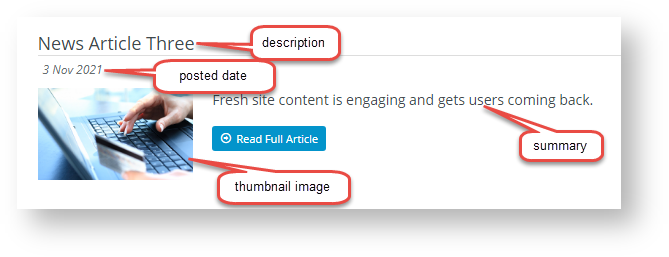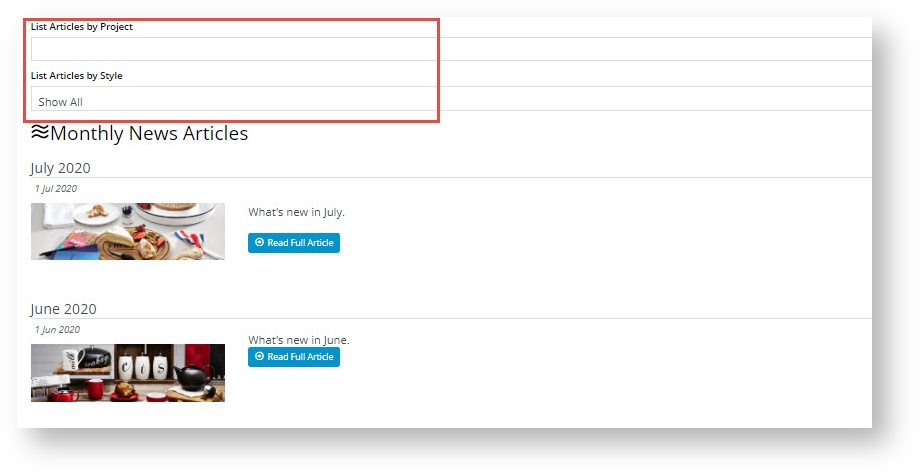...
| Multiexcerpt | ||
|---|---|---|
| ||
| Commerce Vision's Customer Self Service eCommerce Platform websites include an out-of-the-box Article functionality that can be used in various scenarios with content that they can change based on posted, start and finish dates. Whether it's latest news, blogs or FAQs, our article system can help you present fresh content and communicate more effectively with your customers. |
...
This overview provides an introduction to the key aspects of article creation and maintenance on your website.
Enabling and configuring Article Maintenance
In order to maintain articles onlineon your website, the Articles feature must be enabled by the Admin role.
- In the CMS, navigate to Settings → Feature Management → Content.
- Toggle on Articles, then click Configure.
- Toggle on Allow Article Filters if you want any article to have the option of to be able to display an article only to certain segment of site usersset viewer group restrictions on any article.
- Toggle on 'Use Zoned Article Template' if you want any articles article content on your site will be using zoned templatesto use zoned templates. See Article templates help for more details.
- Toggle on Enable Article Template Override if you will be using customised article templates. Note that 'Zoned Article Template' has to must be enabled as well for this feature.
- Toggle on 'Use SEO Url as Article Url' if you want the SEO Url URL to be the article UrlURL.
- To save your settings, click Save & Exit. This will enable online Online maintenance of Articles, and Article Templates (if Article Template Override is enabled), in the CMS via on the 'Content' menu.
Article Types
Articles are grouped into various user-defined types, which can then be selected in article widgets to display. Grouping your articles helps to keep them organised by function or purpose. For example, you might create one article type for FAQs, another for blog posts, and still another for press releases, etc.
To create an article type:
- In the CMS, navigate to Content → Articles.
- Click Add New Article Type.
- Assign your new group a Code, a Name, and an optional Icon (for display in the CMS).
- Click Save. Once an article type has been created, you can add articles for it.
Articles
Once you've got at least one Article Type set up, you can begin creating the articles themselves.
- In the CMS, navigate to Content → Articles.
- Select the Article Type you want your new article to be grouped in.
- Click Add New Article.
- Enter a Description for your article. This will display as the article's title.
- The article's SEO URL, Browser Page Title, and SEO Description will also be auto-populated with the value you enter here. You can change any of these fields if you wish.
- The Posted Date will auto-populate with today's date. If you wish, you can also enter Start & Expiry dates for articles you'd like to display on for a scheduleset period only.
- Select or upload a thumbnail image for the article. This will be the small image that displays when the list of articles is viewed.
- Select or upload the main image for the article. This will be the larger image that displays on the article detail page.
- Enter some 'teaser' text in the Summary section. This is the short-form content displayed when viewing a list of articles.
Enter- In the Content section, enter the main body of the article in the Content section. Use the WYSIWYG editing tools to update font sizes, formats, and colours based on your site's style guide.
- Article Filters allow you to display this article articles to be displayed only to a certain segment of site users. You can enter one or more Filter values: Customer Types, Customer Warehouses, Customer Codes, Bill to Customer Codes, Email Addresses or Roles.
Note - this function works only with standard article widgets. It will not work with custom widgets. (TIP - If you do not see this function, it has not been enabled. Go to Article Feature settings and enable it Settings and toggle on 'Allow Article Filters'.)- Features are user-defined metadata that can be used for article sorting metadata you define for use with article filtering in an article list page, to help website users find relevant articles. You can define them so that they are Feature and feature values should be highly meaningful to your articlesarticle content. Think of a 'feature' as a category and its 'values' as subtypes of the category. As an example, suppose your business sells homewares and produces feature articles on products and designs for different rooms. A 'feature' could then be 'room type' with values such as 'bathroom', 'bedroom', 'loungeroom' etc. Articles can be tagged with particular features and values. Using the Features functionality, visitors to your site can filter for articles about decorating a particular room type, e.g., 'bathroom' or 'bedroom'.
You can add as many features as you require.
In Feature, enter a name for the category. In Value, enter the subtype of this category. Note - for the filters to display when articles are listed, see the how-to guide on Adding a Feature Filter.
What visitors to your site will seeHow site visitors use feature filters:
13. Click Save & Exit.
...
Article Templates and Widgets
Article templates containing various widgets are used to display article-related content on the websiteHow a list of articles (articles of an article type) and an article's content are displayed depend on the templates used and how article widgets have been inserted and configured within each template. There are 3 standard default built-in templates for articles (in Content → Pages & Templates).
...
Depending on your site's requirements and version, you can use these templates, edit them, or even override them and use custom article templates. For detailed help with these templates, see Article Templates help.
...
You can drag and drop these widgets to rearrange them into a different order, if you wish. Or if you want to get really creative, you can use the Layout Creator to customise the look and feel of this page completely.
To access any of these templates and configure the widgets in them,
...









